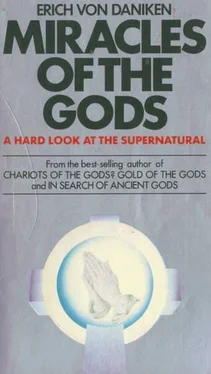Erich Daniken - Miracles of the Gods
Здесь есть возможность читать онлайн «Erich Daniken - Miracles of the Gods» весь текст электронной книги совершенно бесплатно (целиком полную версию без сокращений). В некоторых случаях можно слушать аудио, скачать через торрент в формате fb2 и присутствует краткое содержание. Жанр: Физика, на английском языке. Описание произведения, (предисловие) а так же отзывы посетителей доступны на портале библиотеки ЛибКат.
- Название:Miracles of the Gods
- Автор:
- Жанр:
- Год:неизвестен
- ISBN:нет данных
- Рейтинг книги:4 / 5. Голосов: 1
-
Избранное:Добавить в избранное
- Отзывы:
-
Ваша оценка:
- 80
- 1
- 2
- 3
- 4
- 5
Miracles of the Gods: краткое содержание, описание и аннотация
Предлагаем к чтению аннотацию, описание, краткое содержание или предисловие (зависит от того, что написал сам автор книги «Miracles of the Gods»). Если вы не нашли необходимую информацию о книге — напишите в комментариях, мы постараемся отыскать её.
Miracles of the Gods — читать онлайн бесплатно полную книгу (весь текст) целиком
Ниже представлен текст книги, разбитый по страницам. Система сохранения места последней прочитанной страницы, позволяет с удобством читать онлайн бесплатно книгу «Miracles of the Gods», без необходимости каждый раз заново искать на чём Вы остановились. Поставьте закладку, и сможете в любой момент перейти на страницу, на которой закончили чтение.
Интервал:
Закладка:
Yogananda Paramahamsa, who made such intelligent remarks about suggestive healing, died in Los Angeles on 7th March, 1952. It is said that after three weeks his body showed no signs of decomposition - as is often supposed to be the case after the death of a saintly man. Harry T. Rowe, Director of Forest Lawn Memorial Park, Los Angeles, said in an official report [35]: 'The absence of any signs of decomposition on Paramahamsa's body is the most extraordinary case in all our experience. ... Even twenty days after his death no trace of corporeal decay could be observed .... No smell of decomposition could be noticed throughout this period ....'
The stuff of which saints are made!
Inge Santner writes in Die Weltwoche [36], Zurich, about a lecture given to the Viennese Catholic Academy by the Viennese psychiatrist and neurologist, Dr. Gerhard Kaiser, Lecturer in Forensic Medicine at Salzburg University.
Dr. Kaiser tackled the question of why the bodies of saints retain their shape decades or centuries after their death. Kurt Tucholsky[37] gives a wonderful account of Lourdes in his Book of the Pyrenees: They have recently exhumed her (Bernadette Soubirous) for her canonization next year. Her body was well preserved, her left eye, which was directed at the vision, is reputed to have remained open and her tomb to have smelt so strongly of flowers that letters which lay there smelt, too, so it was said at Lourdes ....
(Bernadette was not a saint at the time; she did not become one till 1933.)
In the opinion of the Viennese scientist it does not need a miracle to preserve the fleshly envelope so that it survives the decades or centuries without visible signs of decomposition. Dr. Kaiser examined such cases as these: Francis of Sales, who died in 1622, was found 'as if he was alive' when exhumed in 1632. His body did not turn to dust until 1665 when it emitted an 'extraordinarily sweet smell'.
Francis Caracciola died in 1608. His flesh and sinews were unchanged when he was exhumed in 1628.
When an incision was made, blood flowed from it.
Carlos Borromaus, died 1584, proved 'unnaturally supple' after medical examination in 1608. His corpse still looked exactly the same 250 years later, in 1880.
St. John of the Cross, who died in 1591, was found covered with pinkish skin when he was dug up in
1859 (!), sweet smelling fluid kept his body moist.
Maria Magdelena de Pazzi, died 1607, did exhibit a blackened face when she was exhumed in 1663, but she still had an 'exceptionally mild expression'.
Bernadette Soubirous, who died in 1879, seemed to be merely sleeping when she was exhumed; her face was only slightly browned and even her clothing had survived the ravages of time undamaged.
Astounding, uncanny, miraculous facts? Dr. Gerhard Kaiser says: 'Wherever the course of events can be reconstructed, signs of miraculous activity must be almost certainly excluded.'
These are the scientific facts: Bodily reactions are not uncommon after death. Cessation of heart beat does not influence all cells simultaneously. Whole groups of cells survive it for several hours. Spermatozoa continue mobile for at least twenty-eight hours after the death of the organism. A well-known phenomenon are the (uncanny)
sighs given by dead people when they are dressed for their last journey and moved in the process.
Survivors are often horrified when they observe changes in position caused by heat. Suspended animation? When a pregnant woman dies, the foetus can be expelled from the body by putrefying gases in the coffin. Suspended animation? No, a chemical and physical process.
Normally the process of decomposition begins very soon after the definite signs of death (coldness of the corpse, rigor mortis, cessation of heart beat and breathing, reddish blue spots on the skin, a negative curve on the instruments). A bubble-like raising of the skin and formation of gas - often with considerable pressure in the corporeal orifices — soon ensues.
The process of putrefaction is mainly caused by air. It carries bacteria, and oxygen sets the chemical conversion process in motion. Moisture and warmth accelerate the decomposition and finally, under ground, worms and insects complete the work of destruction. Ants can lay a skeleton bare in three days! Generally the abdomen dissolves in three or four years, fat in the bones much later. Brain cells and skin on the head last for decades. The protein in the bones lasts for a hundred years or more.
Ultimately all that survives of a dead person buried in a normal grave is the skeleton.
Saintly men who have already demonstrated their singularity in their lifetime by spectacular deeds, are obviously not buried in normal graves or tombs. That is the vital premise from which Dr. Kaiser comes to his convincing conclusions.
The most important prerequisite for the preservation of a corpse is keeping bacteria away. If their presence can be stopped or lessened, the process of putrefaction is slowed down considerably. But how can the environment be influenced to decrease or prevent the access of destructive bacteria?
Dry air and constant strong draughts produce a natural mummification which preserves parts of the body with little flesh on them (ears, nose, fingers, toes).
Cold water flowing in the vicinity of the corpse keeps the temperature down and drives flies and insects away.
This preservative bacteria-reducing cold can be increased by ice. (Bodies have been recovered from glaciers completely undamaged after many years.)
Forensic medicine has histories of corpses found in pitch lakes that were discoloured, but perfectly preserved.
Also well known are bog corpses which are preserved by humus acids resistant to putrefaction. Carbon dioxide prevents the coagulation of the blood. In cases of carbon dioxide poisoning blood can flow from cuts long after death.
Metal coffins cause the formation of metallic salts, which slow down decomposition for as much as ten years. Salts in the earth (arsenic from the iron sources), or sea salts in combination with the dry climate accounted for the hundreds of skulls buried during the Inca period which were found with undamaged flesh and all their hair during excavations in the Lima region. The preservation of bodies by treating them with natron, asphalt and cedar products was known in Egypt from the third century B.C. (Today it is simpler. We mummify with formalin, a germ-killing medium. In many American Memorial Parks relatives can pull their beautifully made-up dead out of compartments and contemplate them in all their living beauty. ... Death in Hollywood!)
Dr. Kaiser has no doubt that the majority of incorruptible saints were buried in such conditions.
The survival of Rose of Lima's flesh was unquestionably due to salts. (The nun, who remained undamaged for eighteen months, lay in the same salt-bearing earth in which the Inca skulls were found.)
St. Clara of Monte Falco was mummified by dry air and found with an 'exceptionally beautiful face'.
Her shorn hair hung above her as a relic 'apparently dried out and showing the face of the crucified Christ'.
The 'smoked Parson of St. Thomas' in lower Austria was rendered incorruptible by chemicals - tar products.
Was it pure chance that saintly people found their burial place in surroundings so favourable to their preservation? There is evidence that suitable methods were used to help preserve the bodies of saints
'in the flesh'. Capuchins in Italy and Moravians laid out the burial chambers of their monasteries in such a way that a constant draught of dry air swept through them. Dr. Kaiser's supposition that the bodies of many saints were not only embalmed with essences, sweet-smelling oils, salves and aromas to drive away the smell of death, but also because the preservative effect of 'cosmetics' was known, can be accepted as a certainty.
Читать дальшеИнтервал:
Закладка:
Похожие книги на «Miracles of the Gods»
Представляем Вашему вниманию похожие книги на «Miracles of the Gods» списком для выбора. Мы отобрали схожую по названию и смыслу литературу в надежде предоставить читателям больше вариантов отыскать новые, интересные, ещё непрочитанные произведения.
Обсуждение, отзывы о книге «Miracles of the Gods» и просто собственные мнения читателей. Оставьте ваши комментарии, напишите, что Вы думаете о произведении, его смысле или главных героях. Укажите что конкретно понравилось, а что нет, и почему Вы так считаете.











